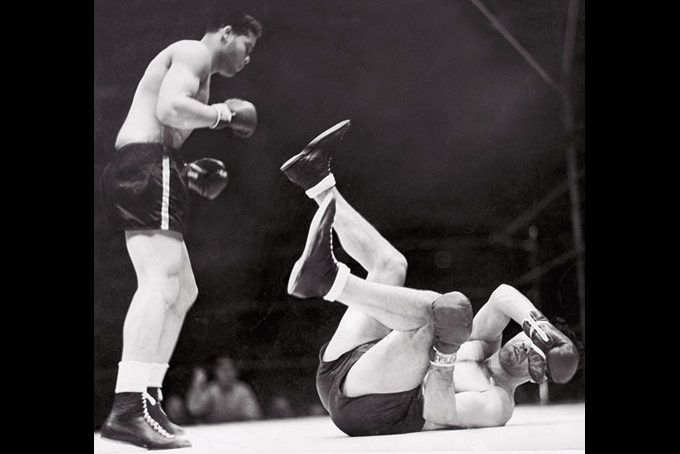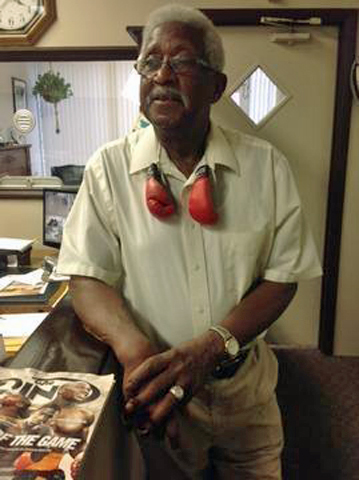
On June 22, 1938, two years after suffering the lone defeat of his prime at the hands of Schmeling — the German puncher who’d been cast as an example of Aryan supremacy — Joe Louis responded with an emphatic first-round knockout before more than 70,000 fans at Yankee Stadium. (AP Photo/File)
by Avis Thomas-Lester
(NNPA)–James “Winky” Camphor , of Baltimore is 86, but he remembers the fight like it happened yesterday.
It was June 22, 1938 and more than 70,000 fight fans crowded into Yankee Stadium to witness a contest that was much more than a boxing bout. It was a grudge match—Black against White, African American versus Aryan, the so-called “Land of the Free” battling Nazi Germany.
 James “Winky” Camphor. (AFRO Photo/Avis Thomas-Lester)
James “Winky” Camphor. (AFRO Photo/Avis Thomas-Lester)
For weeks, Joe Louis, the “Brown Bomber,” and his opponent, Max Schmeling, a beefy German who was supported by Adolf Hitler, had been feted by their respective countries. Americans were hopeful that this time Louis would reign victorious over the German boxer, who had
beaten him in 12 rounds two years earlier.
“The first time, Max Schmeling beat Joe Louis because he found a flaw. He worked on that flaw and he knocked him out,” Camphor said. “Joe Louis later promised his manager that it wouldn’t happen again. He said, ‘I want to fight him again. If I fight him again, you won’t have to go up the steps [into the ring] but one time.’ That meant he would win.”
For Whites, a Louis win would strike a blow against fascism and prove that our nation and its ideals were superior to Hitler’s Deutschland dictatorship.
But for African Americans, a victory would offer the world proof that they were equal, that
they could perform as well as, or better than, anybody—given the opportunity and a level playing field.
To the nation, Louis was a hero. To Blacks, he was a savior.
The Black Press ran stories for weeks in advance of the story. The AFRO was in the forefront
of the coverage, doing stories on everything from the amount of time Louis spent with his wife, Marva, leading up to the fight to a piece about his last workout.
“Louis Sees Many Things as Next Wednesday Nears,” said an AFRO headline on the sports page of the June 18, 1938 edition. “Joe Louis (center) looks into the crystal ball at his training camp…probably to see what the outcome of his fight with Schmeling will be next week,” read the
cutline under a picture of Louis flanked by a turbaned magician and his manager, Joe Roxborough. In another photo, Louis stands between then-former heavyweight contender
Harry Wills and Panama Joe Gans.
“Louis, still thinking of the beating Max gave him two years ago, is not passing up anybody’s advice these days—Jack Johnson’s included,” the cutline said.
As the fight drew close, the nation grew frenzied. In an AFRO story on the June 18 sports page, Staff Correspondent Levi Jolley reported on a Louis sparring practice. “Joe Louis…demonstrated a lightning left, but was the receiver of 51 right hand socks during six rounds of boxing before 3,794 paid admissions, who contributed $4,173 at $1.10 a head…At least 1500 persons had to be turned away.”
William Broadwater, 87, of Upper Marlboro, Md., was 12 at the time. He said the entire country was focused on the fight, but Blacks were obsessed with Joe Louis.
“Joe Louis was to Black people what President Obama is to us today,” he said. “We didn’t have any heroes. There were no Black football players or Major League baseball players. We had had Jesse Owens to win big in the 1936 Olympics, but track and field wasn’t as popular as boxing. We hadn’t had a major Black hero since [boxer] Jack Johnson. Joe Louis was that person.”
Broadwater, like Camphor, said Americans of all hues supported Louis.
“It was the first time White people really got behind a Black person in a big way,” he said. “There was the whole thing of Americans against the Nazis. The Germans were supposed to be the superior race, so (White) people didn’t like that.”
On June 25, the AFRO ran a front page story about the international implications of the fight. Though the fight was fought June 22, the newspaper with the results didn’t reach newsstands until July 2.
“NAZIS AID MAX: Say Hitler Fears Loss; Fight May Play Great Part in International Affairs,” the headline read.
“The German government fears the repercussions which may come from a Schmeling defeat by Joe Louis may react with such far reaching effects to the Hitler regime that a special commission comprising physical educational experts, psychologists, and scientific experts has been sent over to assist the challenger, the AFRO-AMERICAN learned this week,” the story said.
“The AFRO informant, who has just arrived from Germany to attend the fight and spend several weeks in America, says that so grave do certain Nazi officials regard the situation that the Goebbels propaganda department has already carefully prepared a flood of material to be used to counteract the effect a Louis victory may have on the politics in central Europe.”
Broadwater said in his hometown of Bryn Mawr, Pa., neighbors started making plans weeks ahead of time to catch the radio broadcast of the contest.
“On my street, Miller Street, we had two radios. My family had one,” he said. “My father used to mess with ours. He had batteries to run it. They looked like car batteries. I can recall the neighbors coming over days before the fight to ask if they could come down to hear the fight.”
The fight took place at the stadium where Jackie Robinson would break the color barrier in professional baseball four years later. One hundred million people around the world listened, according to historical accounts.